CADILLAC SEVILLE 1997 4.G Manual Online
Manufacturer: CADILLAC, Model Year: 1997, Model line: SEVILLE, Model: CADILLAC SEVILLE 1997 4.GPages: 370, PDF Size: 20.52 MB
Page 81 of 370
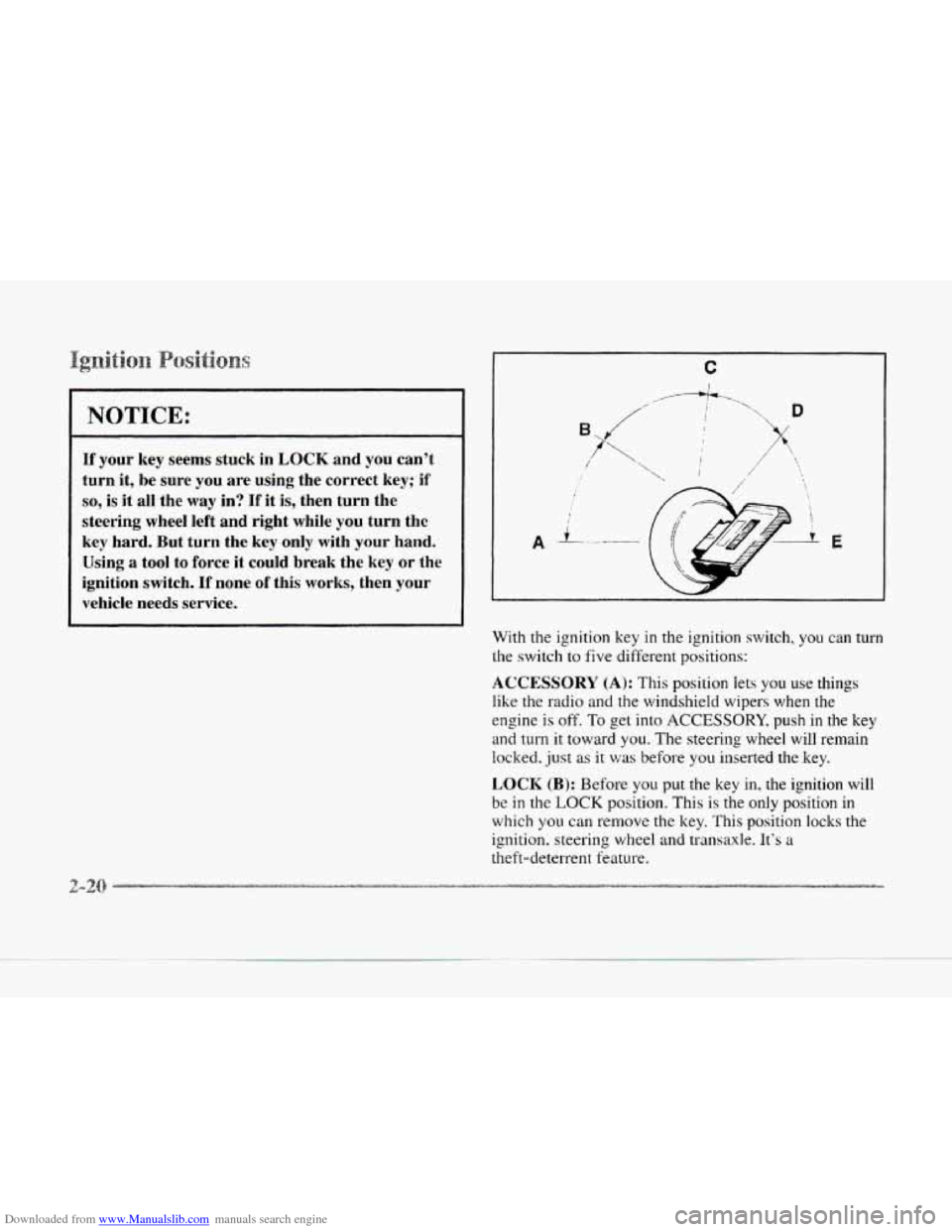
Downloaded from www.Manualslib.com manuals search engine NOTICE:
If your key seems stuck in LOCK and you can’t
turn it,
be sure you are using the correct key; if
so, is it all the way in? If it is, then turn the
steering wheel left and right while you turn thc
key hard. But turn the key only with
your hand.
Using
a tool to force it could break the key or the
ignition switch.
If none of this works, then your
vehicle needs service.
A
C
E
With the ignition key in the ignition switch, you can turn
the switch to five diHerent positions:
ACCESSORY (A): This position lets you use things
like the radio and the windshield wipers when the
engine
is off. To get into ACCESSORY, push in the key
and turn it toward
you. The steering wheel will remain
locked. just as
it was before you inserted the key.
LOCK (B): Before you put the key in, the ignition will
be
in the LOCK position. This is the only position in
which you can remove the key. This position locks the
ignition. steering wheel and transaxle. It’s
a
theft-deterrent feature.
Page 82 of 370
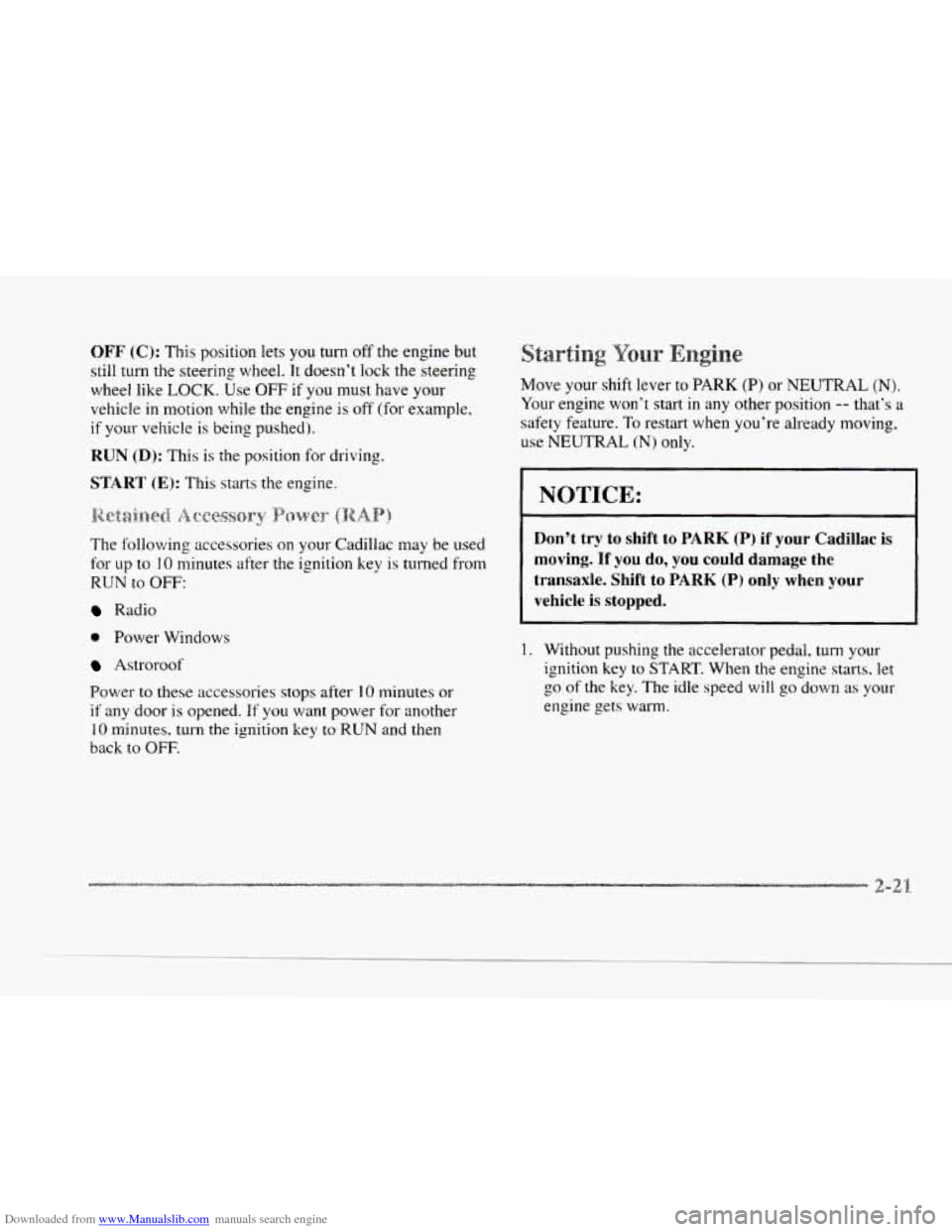
Downloaded from www.Manualslib.com manuals search engine c
OFF (C): This position lets you turn off the engine but
still turn the steering wheel. It doesn’t lock the steering
wheel like
LOCK. Use OFF if you must have your
vehicle
in motion while the engine is off (for example,
if your vehicle is being pushed).
RUN (D): This is the position for driving.
START (E): This starts the engine.
~~.~~:~~~~~~~~ A c.cesso3:y r%2wc3” ~~~~~~~
The following accessories on your Cadillac may be used
for
up to 10 minutes after the ignition key is turned from
RUN
to OFF:
Radio
0 Power Windows
Astroroof
rc-
Power to these accessories stops after 10 minutes or
if any door is opened. If you want power for another
10 minutes, turn the ignition key to RUN and then
back
to OFF.
Move your shift lever to PARK (P) or NEUTRAL (N).
Your engine won’t start in any other position -- that’s a
safety feature. To restart when you’re alreadv moving,
use NEUTRAL (N) only.
NOTICE:
Don’t try to shift to PARK (P) if your Cadillac is
moving. If you do, you could damage the
transaxle. Shift to PARK
(P) only when your
vehicle is stopped.
I. Without pushing the accelerator pedal, turn your
ignition
key to START. When the engine starts. let
go of the key. The idle speed will go down as your
engine gets warm.
Page 83 of 370
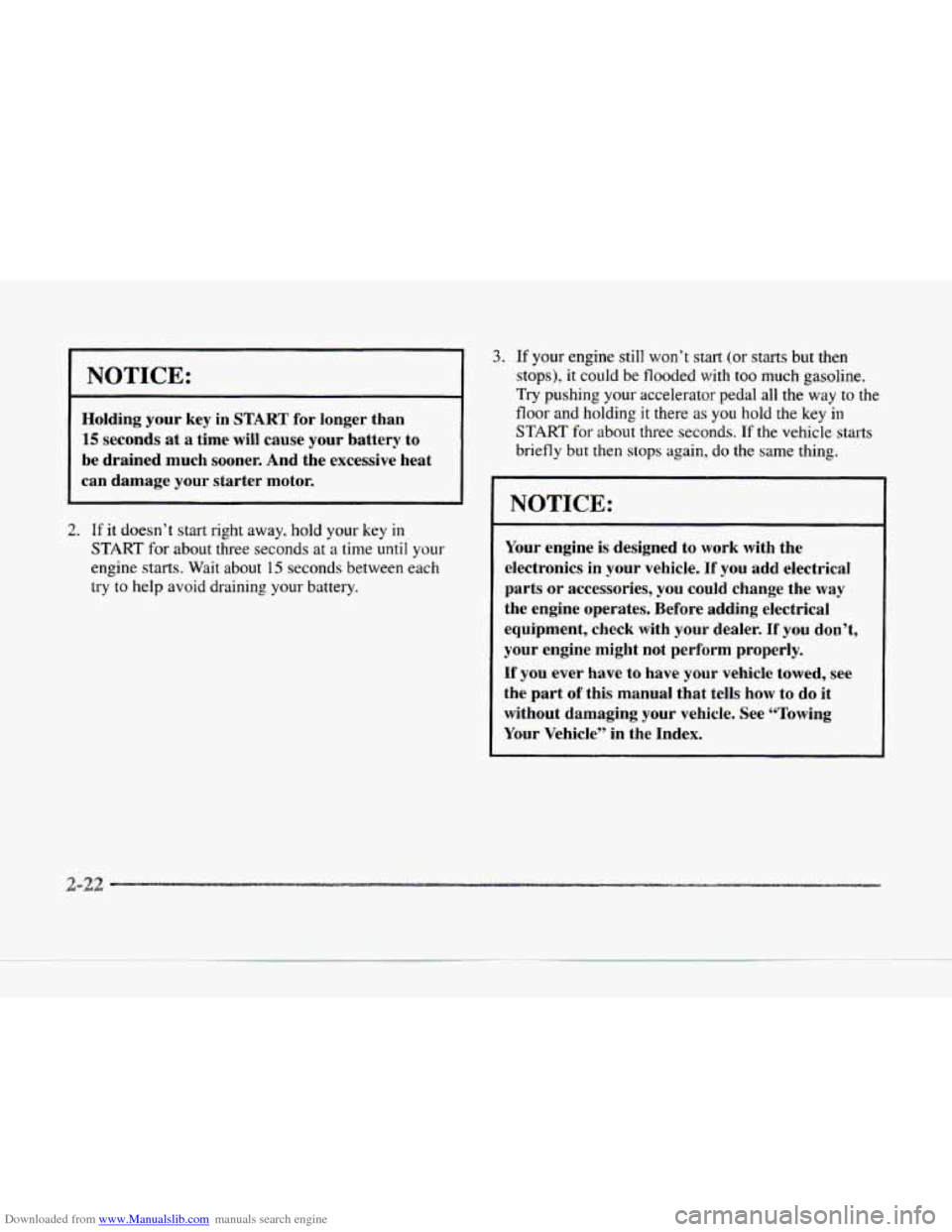
Downloaded from www.Manualslib.com manuals search engine I NOTICE:
~
Holding your key in START for longer than
15 seconds at a time will cause your battery to
be drained much sooner. And the excessive heat
can damage your starter motor.
2. If it doesn’t start right away, hold your key in
START for about three seconds at a time until your
engine starts. Wait about
15 seconds between each
try to help avoid draining your battery.
3. If your engine still won’t start (or starts but then
stops), it could be flooded with too much gasoline.
Try pushing your accelerator pedal all the way
to the
floor and holding
it there as you hold the key in
START for about three seconds.
If the vehicle starts
briefly but then
stops again, do the same thing.
I NOTICE:
Your engine is designed to work with the
electronics in your vehicle.
If you add electrical
parts
or accessories, you could change the way
the engine operates. Before adding electrical
equipment, check with your dealer.
If you don’t,
your engine might
not perform properly.
If you ever have to have your vehicle towed, see
the part
of this manual that tells how to do it
without damaging your vehicle. See “Towing
Your Vehicle”
in the Index.
Page 84 of 370
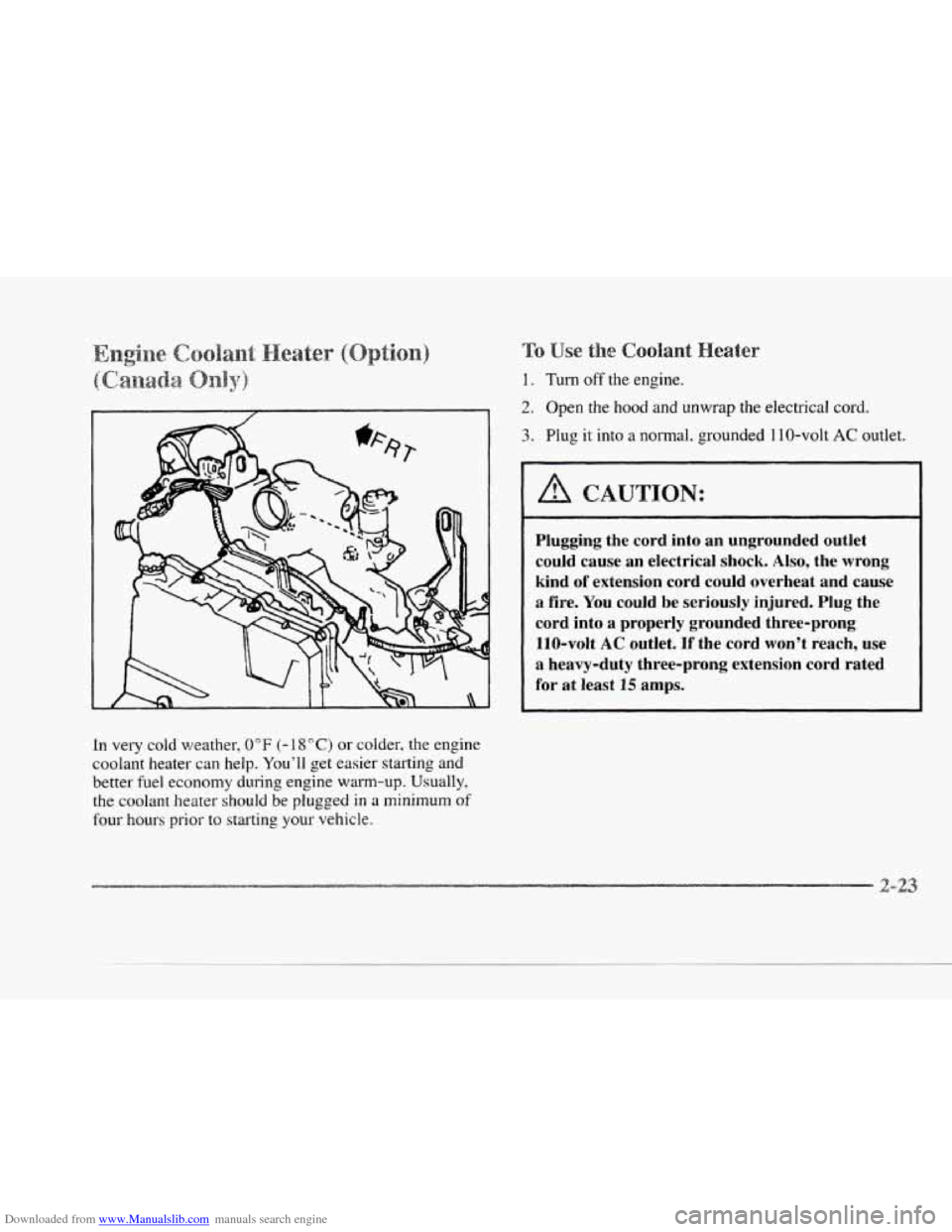
Downloaded from www.Manualslib.com manuals search engine c
rc In very cold weather, 0" F (- 1 8" C) or colder, the engine
coolant heater can
help. You'll get easier starting and
better fuel economy during engine warm-up. Usually,
the coolant heater should be plugged in a minimum of
four hours prior to starting your vehicle.
se the Coolant
1. Turn off the engine.
2. Open the hood and unwrap the electrical cord.
3. Plug it into a normal. grounded 1 10-volt AC outlet.
CAUTION:
Plugging the cord into an ungrounded outlet
could cause an electrical
shock. Also, the wrong
kind
of extension cord could overheat and cause
a fire.
You could be seriously injured. Plug the
cord into a properly grounded three-prong
110-volt
AC outlet. If the cord won't reach, use
a heavy-duty three-prong extension cord rated
for at least
15 amps.
c -23
Page 85 of 370
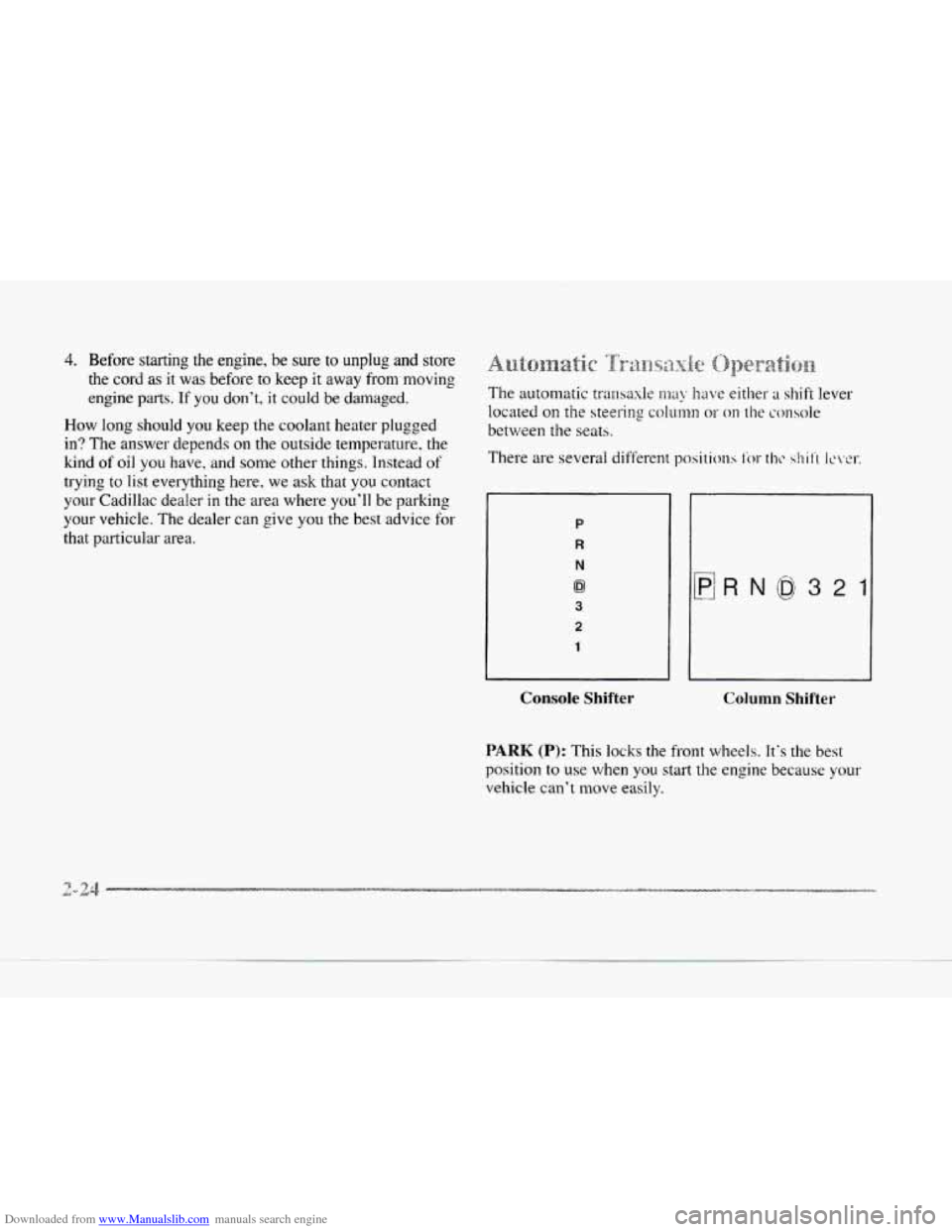
Downloaded from www.Manualslib.com manuals search engine 4. Before starting the engine, be sure to unplug and store
the curd as
it was before to keep it away from moving
engine
parts. If you don't, it could be damaged.
How long should you keep the coolant heater plugged
in? The answer depends on the outside temperature. the
kind
of oil you have, and some other things. Instead of
trying to list everything here, we ask that you contact
your Cadillac deafer
in the area where you'll be parking
your vehicle. The dealer can give
you the best advice for
that particular area. P
R
N
0
3
2
1
Console Shifter Column Shifter
PARK (P): This locks the front wheels. It's the best
position
to use when you start the engine because your
vehicle can't move easily.
Page 86 of 370
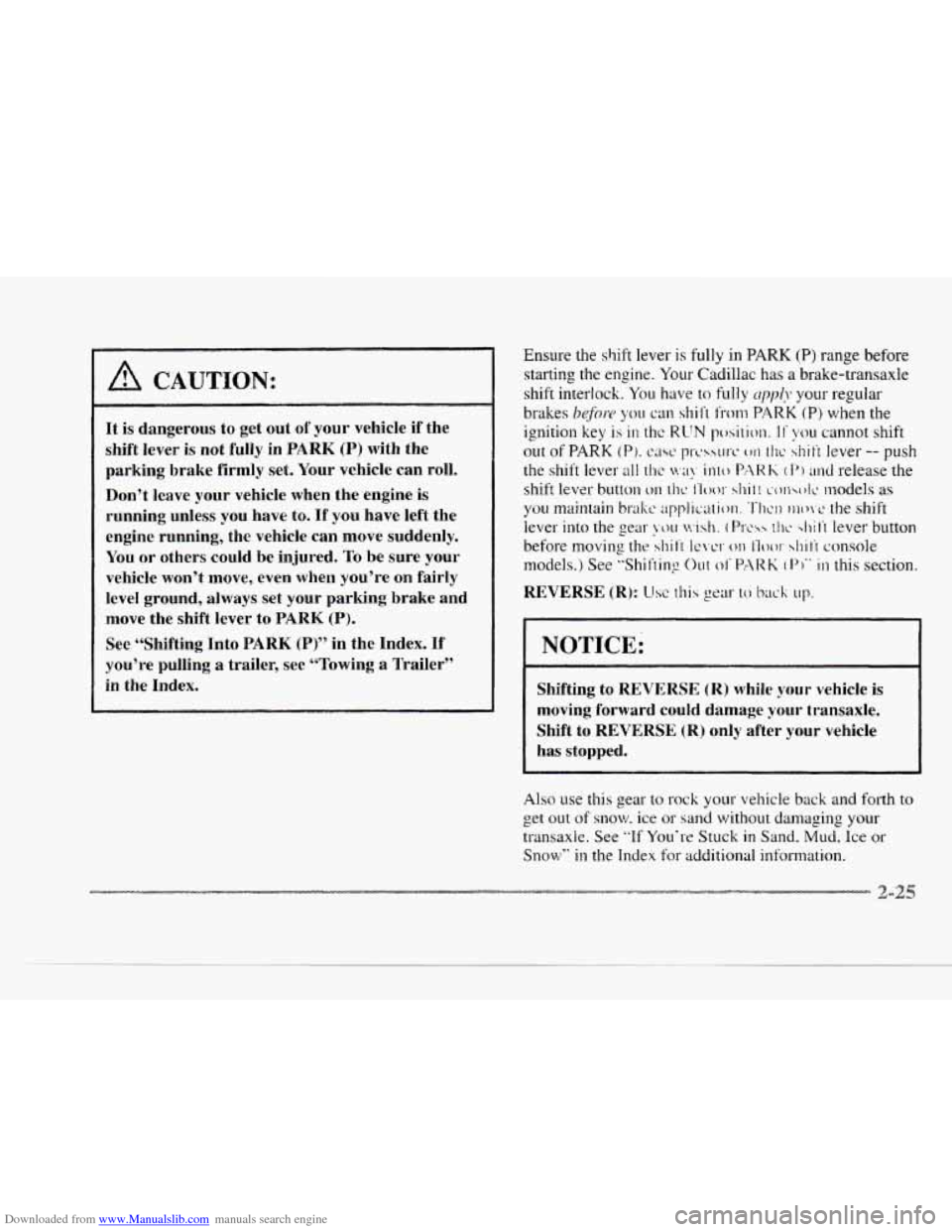
Downloaded from www.Manualslib.com manuals search engine c
CAUTION:
It is dangerous to get out of your vehicle if the
shift lever
is not fully in PARK (P) with the
parking brake firmly set. \’our vehicle can roll.
Don’t leave your vehicle when the engine is
running unless you have to. If
you have left the
engine running,
the vehicle can move suddenly.
I70u or others could be injured. To be sure your
vehicle won’t move, even when you’re
on fairly
level ground, always set your parking brake and
move the shift lever to
PARK (a).
See “Shifting Into PARK (P)” in the Index. If
you9re pulling
a trailer, see “Towing a Trailer”
in the Index. cnsure
the shift lever
is fully in PARK (P) range before
starting the engine. Your Cadillac has
a brake-transaxle
shift interlock.
You have to fully qph your regular
brakes
befory you can shift f’ron? PARK (P) when the
ignition key
is in the RLTN position. I!’you cannot shift
out of PARK (PI. ust‘ pr~~ssurc or] thc shift lever -- push
the shift lever
a11 thc \&+.a!. into PARI< (1’) and release the
shift lever button
on thc: floor shii t cxulhoic models as
you maintain bralit. application. Then IIIO\.C the shift
lever into the gear
~OLI \&:ish. ( p1-c.4~ tflc hi t‘t lever button
before
moving the shit’t le\^^- 011 I’loor shi t‘t console
models.) See ”Shifting Out of‘ PARK PI** in this section.
REVERSE (R): Use t,his pear to iwck 1113.
moving forward could damage your transaxle.
Shift to
REVERSE (R) only after your vehicle
Also use this gear to rock your vehicle back and forth to
get out of snow. ice or sand without damaging your
transaxle. See
“If You‘re Stuck in Sand. Mud, Ice or
Snow” in the Index for additional information.
2-2
Page 87 of 370
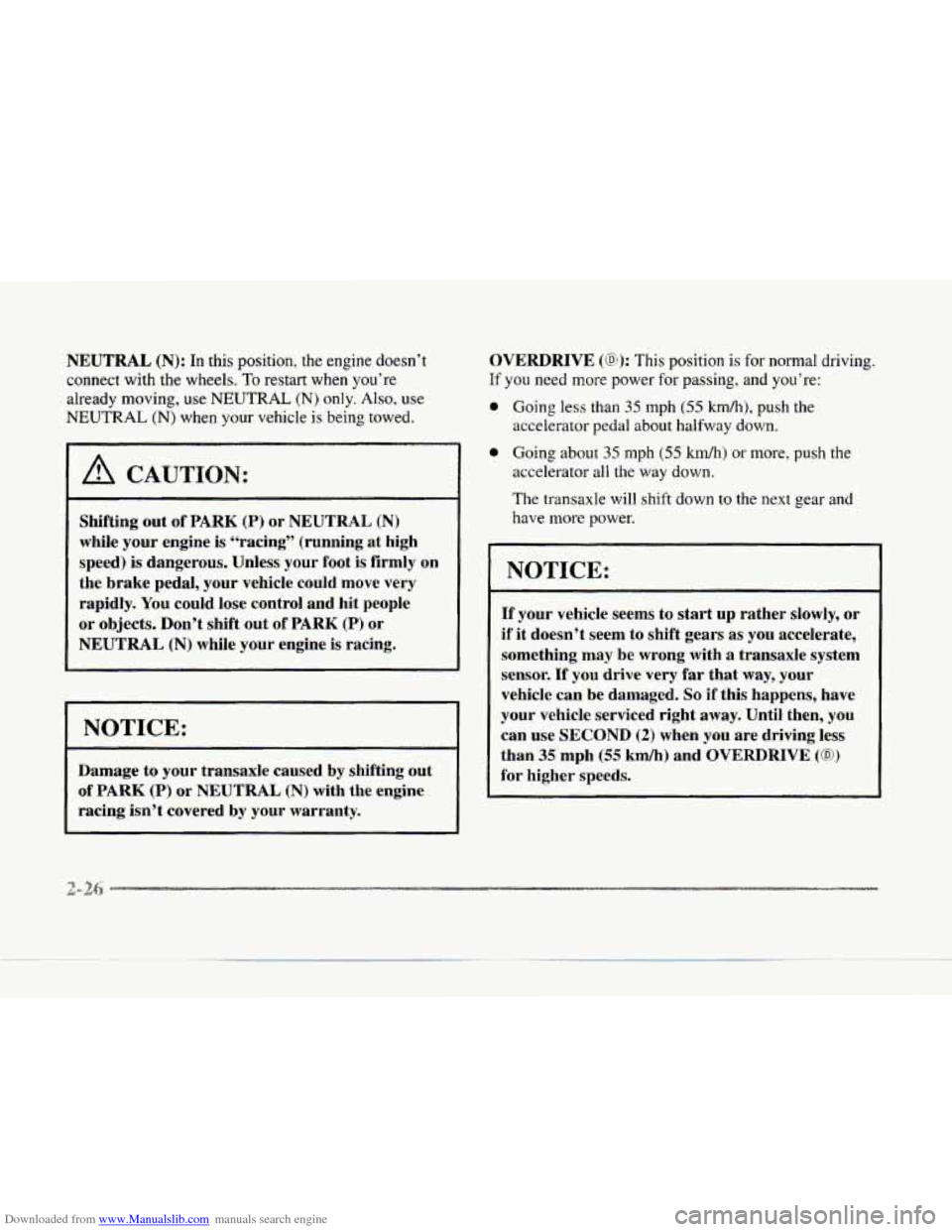
Downloaded from www.Manualslib.com manuals search engine NEUTRAL (N): In this position, the engine doesn’t
connect with the wheels.
To restart when you’re
already moving, use
NEUTRAL (N) only. Also, use
NEUTRAL (N) when your vehicle is being towed.
A CAUTION:
Shifting out of PARK (P) or NEUTRAL (N)
while your engine is “racing” (running at high
speed)
is dangerous. IJnless your foot is firmly on
the brake pedal, your vehicle could move very
rapidly. You could lose control and hit people
or objects. Don’t shift out of
PARK (P) or
NEUTRAL (N) while your engine is racing.
NOTICE:
Damage to your transaxle caused by shifting out
of PARK (P) or NEUTRAL (N) with the engine
racing isn’t covered
by your warranty.
OVERDRIVE (a)): This position is for normal driving.
If you need more power for passing, and you’re:
0 Going less than 35 mph (155 kmh), push the
accelerator pedal about halfway down.
0 Going about 35 mph (55 km/h) or more, push the
accelerator all the way down.
The transaxle will shift down to the next gear and
have more power.
NOTICE:
~~~ ~~ ~-
If your vehicle seems to start up rather slowly, or
if it doesn’t seem to shift gears as you accelerate,
something may be wrong with
a transaxle system
sensor.
If you drive very far that way, your
vehicle can be damaged. So if this happens, have
your vehicle serviced right
away. Until then, you
can use SECOND (2) when you are driving less
than
35 mph (55 km/h) and OVERDRIVE (GO)
for higher speeds.
Page 88 of 370
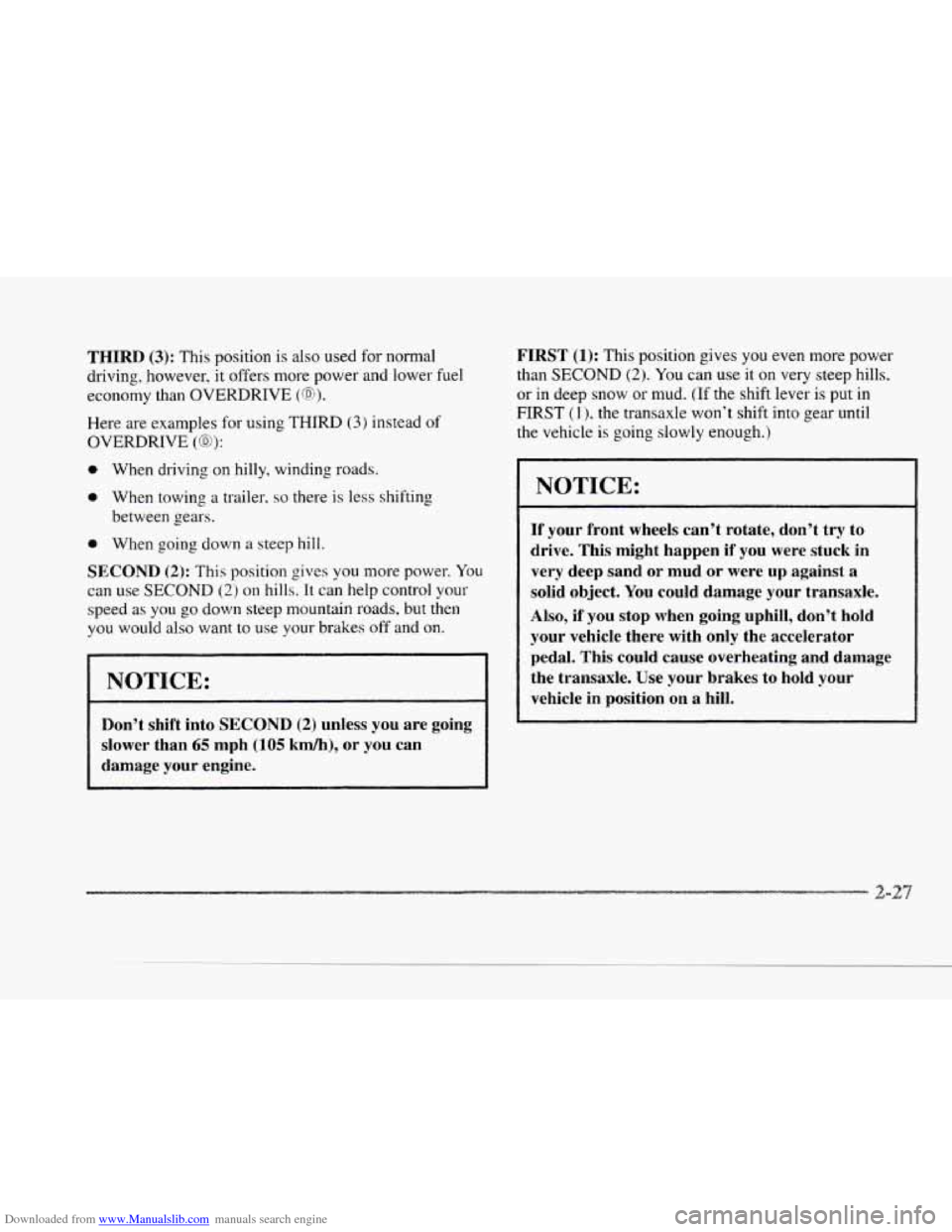
Downloaded from www.Manualslib.com manuals search engine c
c
THIRD (3): This position is also used for normal
driving, however,
it offers more power and lower fuel
economy than OVERDRIVE
(@).
Here are examples for using THIRD (3 j instead of
OVERDRIVE (@) j:
0 When driving on hilly, winding roads.
0 When towing a trailer. so there is less shifting
between gears.
0 When going down a steep hill.
SECOND (2): This position gives you more power. You
can use SECOND (2) on hills. It can help control your
speed
as you go down steep mountain roads, but then
you would also want to use your brakes off and on.
.__
NOTICE:
Don’t shift into SECOND (2) unless you are going
slower than
65 mph (105 km/h), or you can
damage your engine.
FIRST (1): This position gives you even more power
than SECOND
(2). You can use it on very steep hills,
or in deep snow or mud. (If the shift lever is put in
FIRST (1). the transaxle won’t shift into gear until
the vehicle is
going slowly enough.)
NOTICE:
If your front wheels can’t rotate, don’t try to
drive. This might happen
if you were stuck in
very deep sand or mud or were up against a
solid object. You could damage your transaxle.
Also, if you stop when going uphill, don’t hold
your vehicle there with only the accelerator
pedal. This could cause overheating and damage
the transaxle. Use your brakes
to hold your
vehicle
in position on a hill.
Page 89 of 370
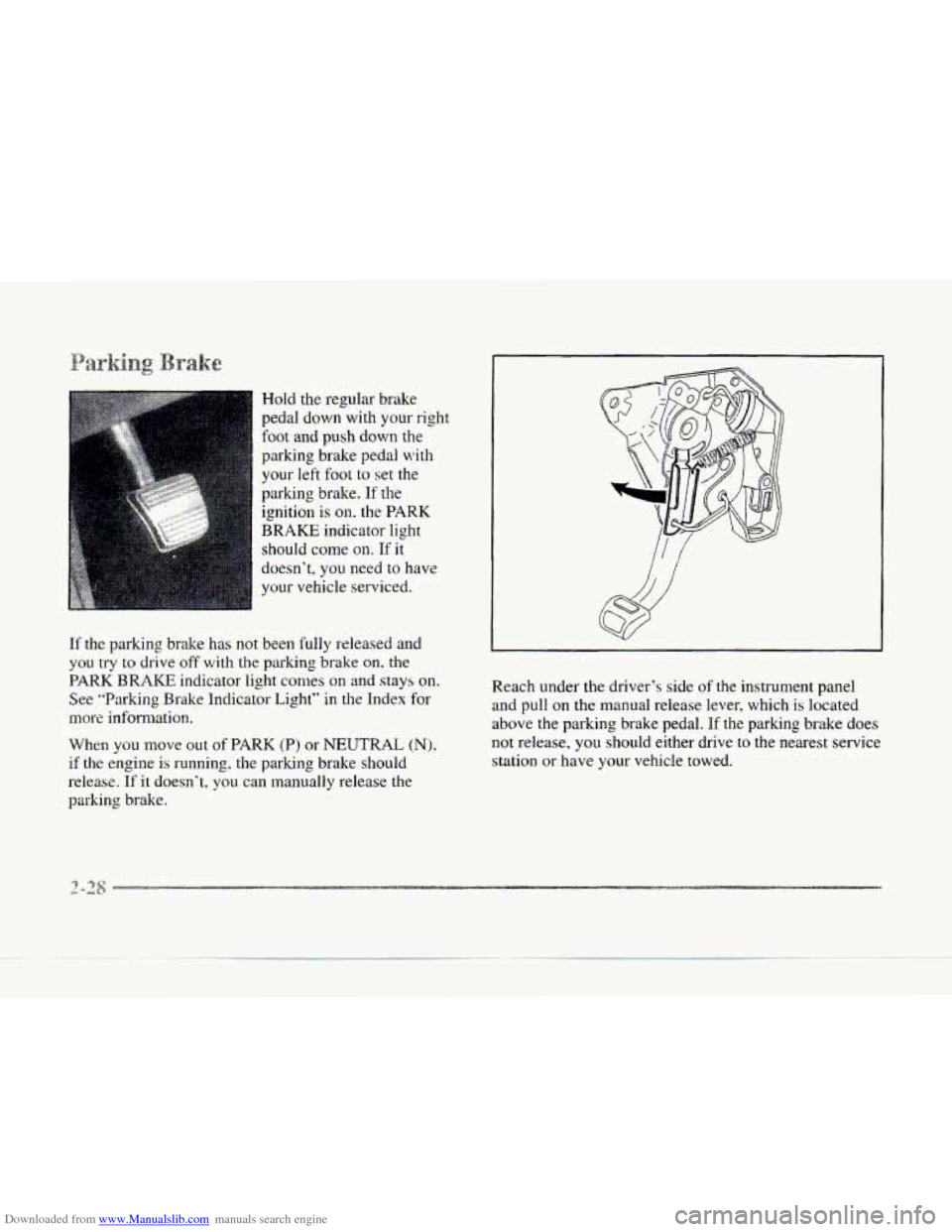
Downloaded from www.Manualslib.com manuals search engine c
Hold the regular brake
pedal down with your right
foot and
push down the
parking brake pedal with
your
left foot to set the
parking brake. If the
ignition is
on. the PARK
BRAKE
indicator light
should come
on. If it
doesn’t, you need to have
your vehicle serviced.
If the parking brake has not been fully released and
you try to drive off with the parking brake on. the
PARK BRAKE indicator light comes on and stays on.
See ’bParking Brake Indicator Light” in the Index for
more information.
When
you move out of PARK (P) or NEUTRAL (N),
if the engine is running, the parking brake should
release.
If it doesn’t. you can manually release the
parking brake. Reach under
the driver’s side of the
instrument panel
and pull
on the manual release lever, which is located
above the parking brake pedal. If the parking brake does
not release,
you should either drive to the nearest service
station or have your vehicle towed.
Page 90 of 370
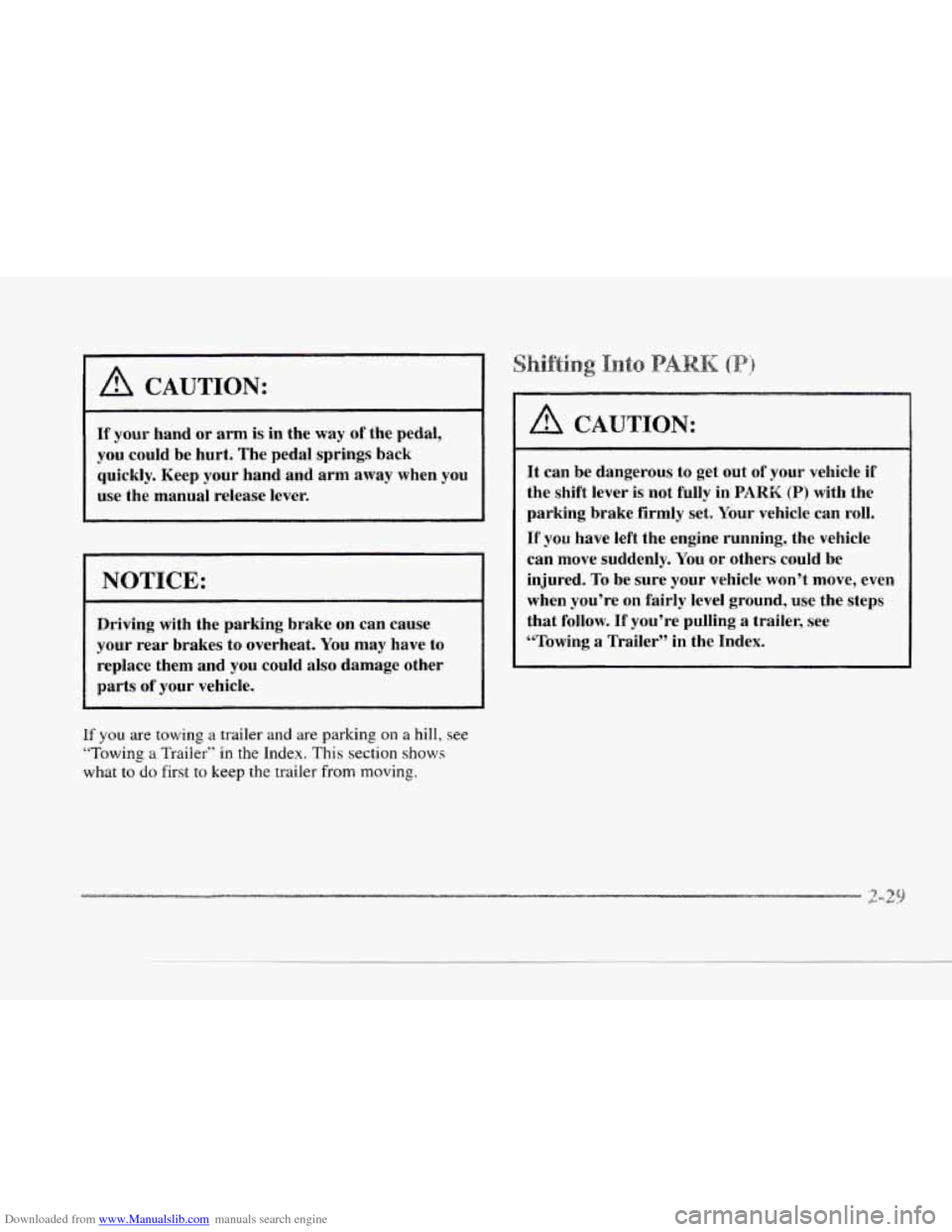
Downloaded from www.Manualslib.com manuals search engine I A CAUTION:
If your hand or arm is in the way of the pedal,
you could be hurt. The pedal springs back
quickly. Keep your hand and
arm away when you
use the manual release lever.
NOTICE:
Driving with the parking brake on can cause
your rear brakes to overheat.
You may have to
replace them and
you could also damage other
parts
of your vehicle.
If you are towing a trailer and are parking on a hill, see
what to do first to keep the trailer from moving.
6b Towing a Trailer” in the Index. This section shows
A CAUTION:
It can be dangerous to get out of’ your vehicle if
the shift lever is not fully in PARK (P) with the
parking brake firmly
set. Your vehicle can roll.
If you have left the engine running, the vehicle
can move suddenly.
You or others could be
injured.
To be sure your vehicle won’t move, even
when you’re
on fairly level ground, use the steps
that follow.
If you’re pulling a trailer, see
“Towing a Trailer” in the Index.